In brief
- Dual-purpose canola offers profitable winter forage for sheep and grain for harvest
- Some growers have used dual-purpose canola to improve profit by almost 50 per cent
- CSIRO researchers have demonstrated that sowing dual-purpose canola and wheat across 10 to 20 per cent of the farm can lift profits by up to $200 a hectare
- In high and medium-rainfall areas, dual-purpose canola provides an excellent weed and disease break for dual-purpose wheat
- In lower-rainfall areas, it reduces risk by providing grazing income to offset crop establishment costs
Mixed farmers keen to supercharge business returns will find plenty of interest in dual-purpose canola.
CSIRO researchers have estimated the value of incorporating dual-purpose canola into Australian mixed farming systems at more than $1 billion over the past 15 years.
While some GroundCover™ readers may already be familiar with the gains that are possible from dual-purpose canola, reviewing how the crop was developed – and its advantages to farming systems – is a valuable exercise, particularly for those new to the cropping industry or seasoned growers looking to generate higher returns.
A new concept
CSIRO Agriculture and Food chief research scientist Dr John Kirkegaard planted his first dual-purpose canola trials in 2004 to explore the impact of grazing on grain production.
“In the high-rainfall areas, dual-purpose cereals were profitable, but growers with grass-dominant pastures had no break crop option and were running into problems with weeds and diseases,” Dr Kirkegaard says.
Accordingly, he and his CSIRO colleagues were determined to explore how well canola recovered when grazed at various stocking rates and the effects on grain yields.
Those proof-of-concept trials compared ungrazed canola with canola grazed at both light and heavy stocking rates. They also compared the palatability of canola with European forage brassicas.
“To our surprise, the first grazed canola crops grew back well with minimal effect on a final grain yield of about three tonnes per hectare,” Dr Kirkegaard says.
“We were excited by the results, so in 2005 we invited growers and advisers to see the grazed canola immediately after we had removed the sheep and later when the crops had recovered.
“Those who visited our trials – including Delta Agribusiness senior farm consultant Tim Condon – were enthusiastic about the idea of dual-purpose canola and became involved in our early research.”
Accordingly, in 2007, they implemented the first on-farm test of a European canola variety. This was planted at Bobbara Station, near Galong in southern New South Wales.
Blackleg hurdle
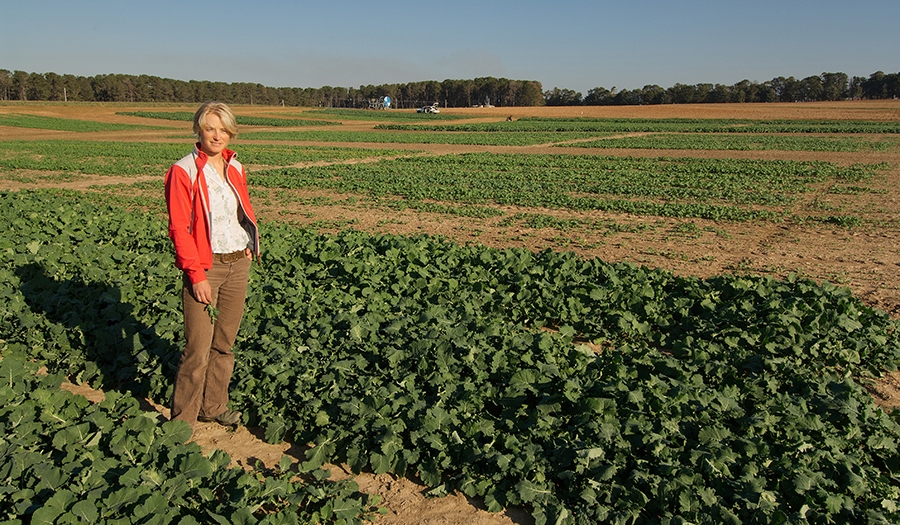
CSIRO Agriculture and Food senior research scientist Dr Susie Sprague in early trials on dual-purpose canola that proved blackleg-resistant varieties could be sown and successfully grown for grazing and grain production. Photo Brad Collis
Meanwhile, Dr Kirkegaard says one of the first tasks in developing dual-purpose canola was to ensure blackleg disease could be managed.
“Blackleg spreads when aerial spores – released during autumn and winter – enter plants through small openings known as the stomata in leaves,” he says.
“Back then, we thought that sheep grazing canola would increase the blackleg risk.
“CSIRO Agriculture and Food senior research scientist Dr Susie Sprague did most of the work in those early years to ensure growers could manage the disease. Her research demonstrated that planting canola varieties highly resistant to blackleg would limit the incidence of disease resulting from grazing.
“She also showed that removing grazing animals before stem elongation limited the incidence of blackleg infection. Her work gave us the confidence to graze canola without increasing the blackleg risk.”
Animal factors
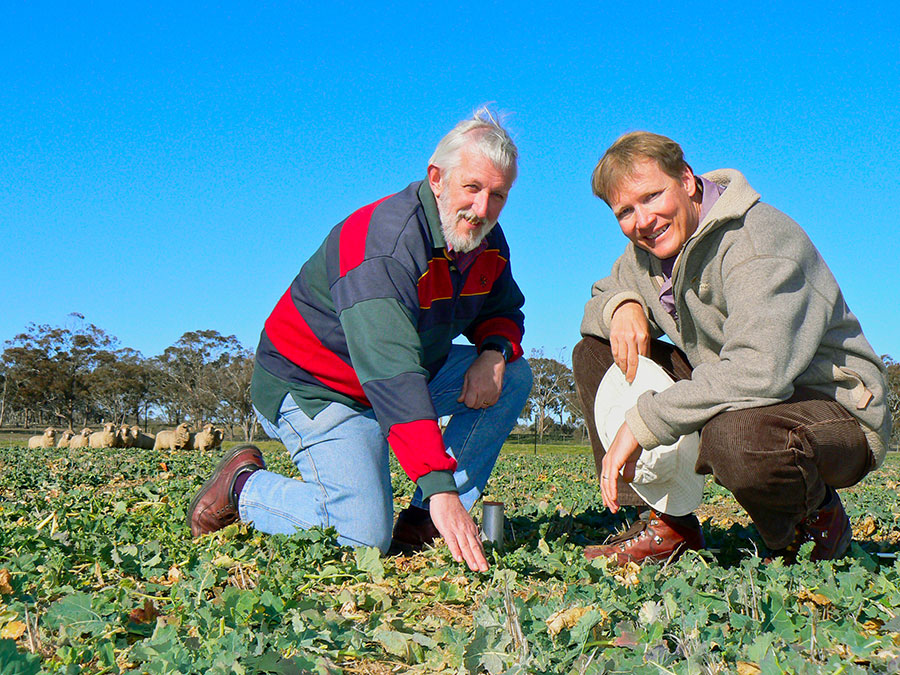
Back in 2006, Dr John Kirkegaard (right), with fellow CSIRO researcher the late Dr Hugh Dove, were exploring the dry matter production of dual-purpose canola at CSIRO’s Ginninderra Experimental Research Station, Australian Capital Territory. Photo: Nicole Baxter
At the same time, the late CSIRO researcher Dr Hugh Dove and his assistant Scott McDonald were exploring the palatability of canola, the growth rates of sheep grazing canola and whether there were any animal health issues.
Their work demonstrated that canola is highly digestible (more than 80 per cent) because it is high in crude protein (more than 20 per cent) and metabolisable energy (12 to 14 megajoules per kilogram).
“Sometimes sheep require roughage when grazing canola and need to be introduced to the crop gradually and have access to a plentiful water supply,” Dr Kirkegaard says. “But the research demonstrated that these issues were manageable.”
The research also showed that cattle were more sensitive to nitrate levels in canola than sheep, which led some growers only to graze cattle on cereal crops.
Crop recovery
Another research focus was determining how well the crop recovered after grazing. This involved investigating the timing and intensity of grazing and the timing of lock-up.
“We showed that removing the animals before the stems had elongated too far was critical,” Dr Kirkegaard says. “If the animals were biting off too many buds, flowering was delayed into a period when the heat and moisture risk was higher, which often reduced yield.
“Also, if there wasn’t sufficient residual biomass by the time the crop was in its critical period for grain production during flowering, we couldn’t achieve high yields comparable to the ungrazed canola.
“The result was a set of rules-of-thumb around grazing, lock-up and recovery for particular yield targets.”
Yield benefits
After gathering these insights, the researchers wanted to determine where grazing canola had potential in Australia, so computer simulation modelling studies were the next step.
CSIRO Agriculture and Food’s Dr Julianne Lilley and Dr Lindsay Bell, working with Charles Sturt University’s Dr Jeff McCormick, determined the potential grazing days and grain yield benefits of dual-purpose canola across high-rainfall areas of Australia (Figure 1).
“They also looked at the likelihood of an early sowing opportunity, which is required by dual-purpose canola,” Dr Kirkegaard says.
“The earlier you sow, the higher the level of vegetative biomass for winter types of canola, which allows for more grazing days before locking up the paddock.”
Figure 1: Simulated sowing opportunity, grazing days and wheat and canola grain yields across Australia.
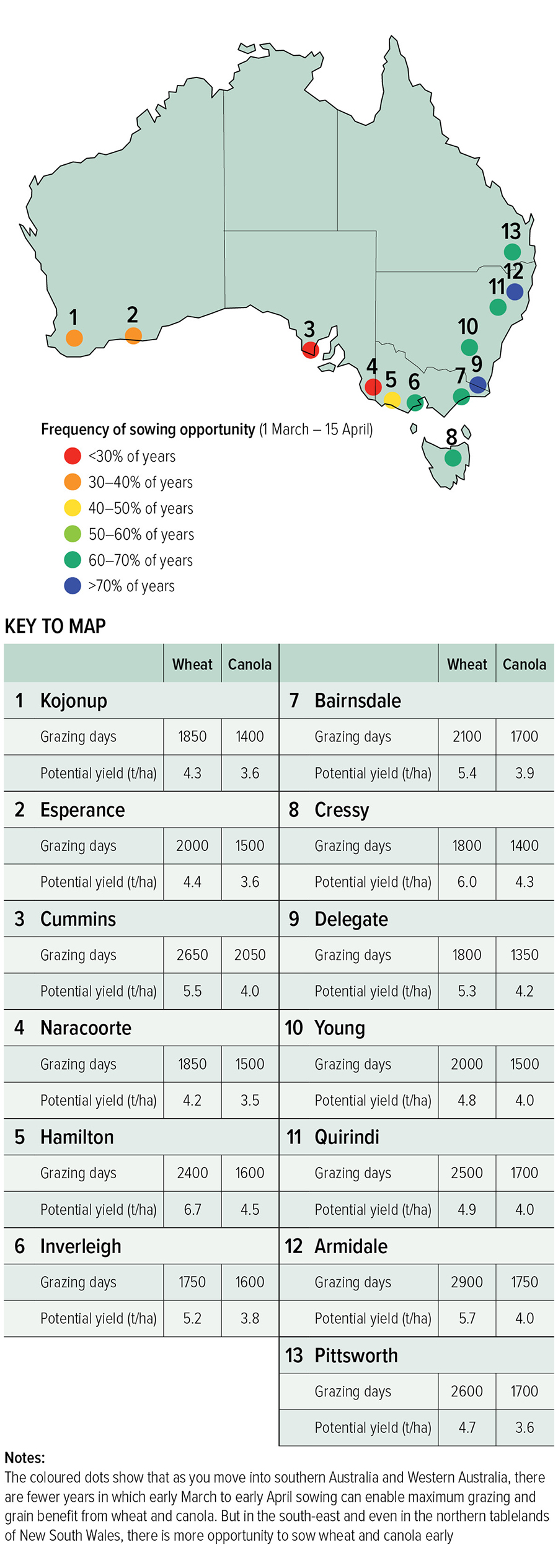
Source: CSIRO Agriculture and Food and Charles Sturt University.
Whole-farm benefits
In 2010, the research was scaled-up to explore the benefit of integrating dual-purpose canola across a whole farm system.
Dr Kirkegaard says the first experiment was located outside Canberra in the Australian Capital Territory to explore an integrated farming system of dual-purpose wheat, dual-purpose canola and pasture grazing.
“We wanted to understand the value of running grazing animals on dual-purpose canola and wheat, which allows pastures to be destocked during winter to allow a bank of feed to build for spring grazing,” he says.
“Having dual-purpose canola and wheat in the system enabled a more extended grazing period because the animals could graze the canola and then move on to the wheat, allowing pastures to be spelled for longer.
“The dual-purpose canola could also act as a weed and disease break for the dual-purpose wheat that would otherwise persist in a pasture/wheat farming system.”
At the end of the research phase, CSIRO’s Dr Bell demonstrated that introducing dual-purpose crops to 15 per cent of the farm could substantially increase whole-farm returns (Figure 2). This is based on grazing value and added grain production where canola has replaced pasture.
Figure 2: Change in farm returns ($/ha) from adding dual-purpose wheat, dual-purpose canola and dual-purpose wheat and canola together across different percentages of the farm area.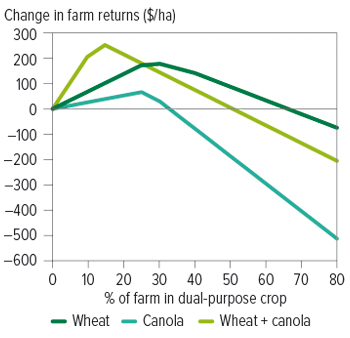
Source: Bell et al. (2015), Crop and Pasture Science 66, 390–398.
Dr Kirkegaard says another experiment, which ran from 2013 to 2016, involved a series of small ‘farmlets’ where sheep were followed through an entire year and areas were sown to dual-purpose crops in rotation with pasture (canola/wheat/pasture/pasture).
“We monitored other areas that represented the rest of the farm when the animals weren’t grazing the dual-purpose crops,” he says. “We had control treatments where the animals only had access to the perennial pasture.”
The researchers demonstrated that whole-farm profit increased by $207 per hectare when giving animals access to dual-purpose crops across 33 per cent of the farm.
“Accordingly, we demonstrated that if you can graze a crop and still achieve the same grain yield, the paddock-scale profit was increased by $300 to $1000/ha,” Dr Kirkegaard says.
He says other benefits of dual-purpose canola include:
- having the capacity to sow part of the farm early with winter canola;
- increased winter stocking rates, which is useful when trading stock;
- higher animal growth rates during autumn, which allows animals to be turned off earlier or at higher weights;
- pasture spelling while stock is grazing dual-purpose crops; and
- spreading the workload and improving risk management by having the flexibility to harvest the crop for grain if spring conditions are wet or continue grazing or making hay or silage if the season turns dry.
Improved returns
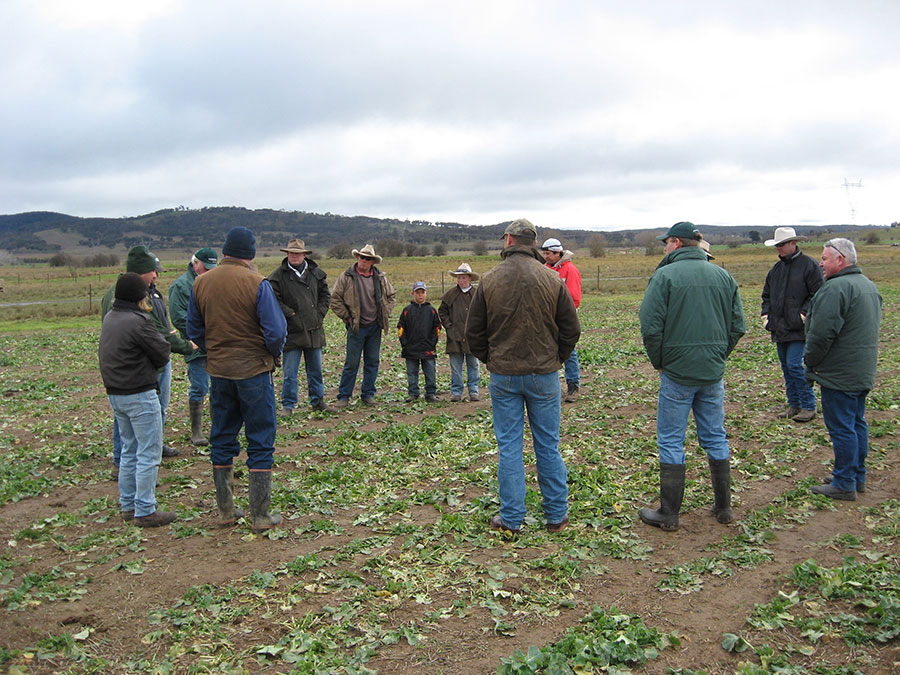
A field day at Angus Gibson’s farm near Goulburn, New South Wales. Photo: John Kirkegaard
Mixed farmer Angus Gibson has significantly improved profit by adding dual-purpose canola and wheat to his farming system near Goulburn, NSW.
He started experimenting with dual-purpose canola and wheat in 2009 to manage weeds and diseases better.
Before 2009, his 900ha farm was 100 per cent grazed. His sheep grazed 600ha of native pasture and 300ha of improved pasture.
But in 2009, he started transitioning the farm to include 300ha of grazed winter canola and wheat. Dr Kirkegaard says the cropping phase is pivotal to Angus’s pasture improvement. This is because the dual-purpose crop profit (especially from canola) can pay for lime, seed and fertiliser to underpin the establishment of the perennial grass/legume-based pasture. Also, the previously intractable grass-weed serrated tussock can now be controlled in the cropping phase.
Another benefit of dual-purpose canola, Dr Kirkegaard says, is that it provides grass weed and disease control for wheat in the cropping phase, improving both forage yield and grain yield by about 1t/ha compared with continuous wheat.
“To capitalise on the higher levels of autumn and winter forage produced by the crops, meat enterprises and livestock trading often augment self-replacing flocks,” Dr Kirkegaard says.
“Rather than sell weaners as store animals, they could be value-added to grow to prime stock. Trading lambs on the dual-purpose crops is highly profitable and, together with grain income, creates a significant increase in the gross margin from the grazing enterprise.”
Improved pastures
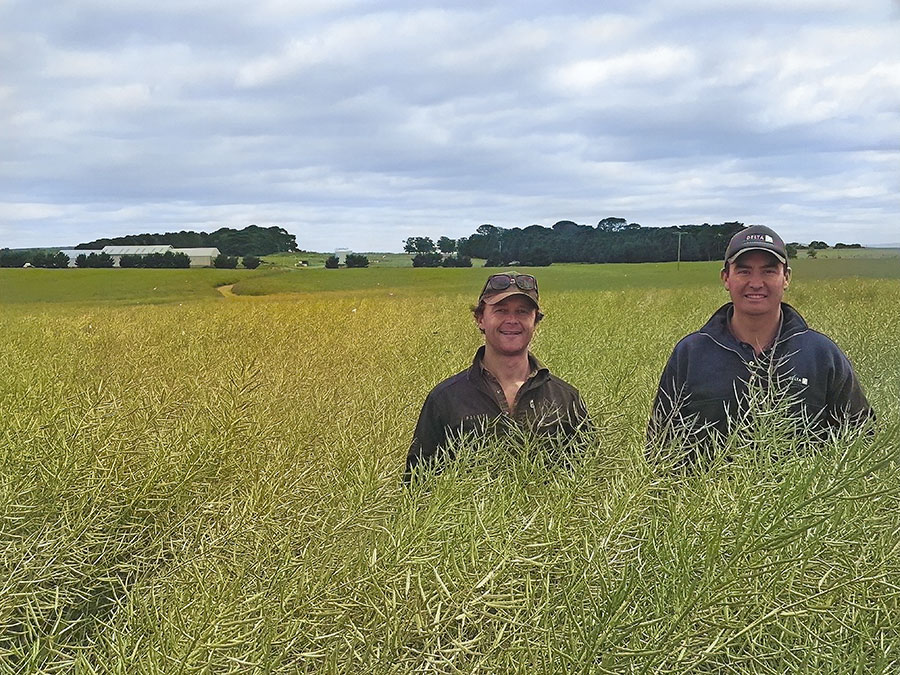
James Maple-Brown and his adviser Delta Agribusiness agronomist James Cheetham in a dual-purpose canola crop near Goulburn, New South Wales. Photo: John Kirkegaard
Another grower, James Maple-Brown, who farms near Goulburn, NSW, switched to dual-purpose canola and wheat in 2012 to finance pasture improvement across his 3500ha farm.
Dual-purpose canola also offered the chance to manage weeds and diseases better in his grazing cereals.
“James had been grazing a small amount of triticale and was moving to wheat,” Dr Kirkegaard says. “He was particularly looking for annual ryegrass control and disease control.”
James’s farming system comprises about 10 per cent dual-purpose canola, which is rotated with 10 per cent dual-purpose wheat.
His spring lambs are weaned in November and shorn in March. When those animals come off shears, the wethers and ewe lambs are put on canola from April to July. Wether and ewe lamb growth rates are about 200 grams/day for 90 to 100 days. This leads to an earlier turn-off or heavier lambs.
Other benefits of dual-purpose canola, according to James, include:
- ewe-hoggets cutting up to 1kg of extra wool;
- increased joining rates of maiden ewes;
- pasture improvements from increased fertility after crops;
- reduced risk and flexible exit strategies of the crops in drought (graze-out, hay, silage); and
- less hand feeding, which was previously required in autumn.
Dr Kirkegaard says James has estimated that dual-purpose canola has added an extra $40/head to 6000 lambs/year.
“He uses the cropping phase to clean up weeds and diseases and to move to an improved pasture phase,” he says. “The improved pasture comprises lucerne and phalaris, and dual-purpose canola and wheat have lifted the productivity of the pastures.”
The outcome, he says, is growing crops on 20 per cent of his farm while running the same number of sheep.
“Crop grazing allows the same amount of sheep to be run on 80 per cent of the farm while producing and selling grain,” Dr Kirkegaard says.
“Dual-purpose canola is now generating 25 per cent of the profit from just 10 per cent of the farm.”
Team honoured
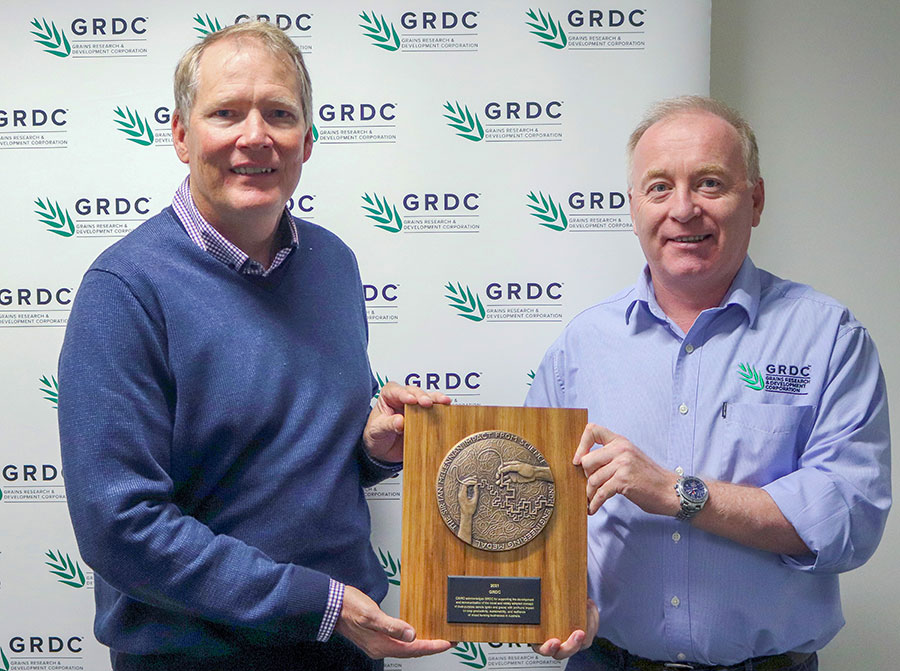
CSIRO Agriculture and Food’s Dr John Kirkegaard with GRDC managing director Nigel Hart and the 2021 CSIRO Sir Ian McLennan Impact from Science and Engineering Medal. The citation reads: CSIRO acknowledges GRDC for supporting the development and communication of the novel and widely accepted concept of dual-purpose canola (grain and graze) with a profound impact on crop productivity, sustainability, and resilience of mixed farming businesses in Australia. Photo: Lee Vereschildt
Dr Kirkegaard and his team received the 2021 CSIRO Sir Ian McLennan Impact from Science and Engineering Medal for developing and extending the science around dual-purpose canola.
The broader research team comprised Susie Sprague, Julianne Lilley, Lindsay Bell, Hugh Dove, Tony Swan, Melanie Bullock, Scott McDonald and Bruce Isaac.
“It’s estimated that since 2007, dual-purpose canola has added more than $1 billion to the Australian economy and is worth about $200 million annually across 200,000 hectares,” Dr Kirkegaard says.
“Nonetheless, one of the limitations of further uptake of dual-purpose canola is that growers need access to more seed to grow the crop, demonstrating the continuing high demand for grazing and grain canola.”
Collaboration critical
Dr Kirkegaard also praised the input from the collaborating advisers and growers who were prepared to trial dual-purpose canola in its early stages to help iron out the practical ‘bugs’ and provide an ongoing refinement to the management strategies.
“Early input came from Tim Condon and Chris Duff and the wider Delta Agribusiness team who supported testing, while growers including Peter Brooks and Angus Gibson from Goulburn, NSW, and Rod and Nick Kershaw from Greenethorpe, NSW, hosted field trials for many years,” he says.
“These growers have now integrated dual-purpose canola successfully into their businesses and continue to assist in ongoing experiments.
“We are also thankful for Kalyx’s Peter Hamblin, CSIRO, GRDC and Meat and Livestock Australia for investment in this work that has helped improve business resilience for many Australian grain growers.”
New guide
While much of the science for dual-purpose canola is settled, Dr Kirkegaard and his team are coordinating the development of a new guide to further advance crop uptake by mixed farmers keen to maximise returns.
The guide, developed with GRDC investment, is expected to be released later this year.
Does dual-purpose canola rob soil moisture from following crops?

Dr Kirkegaard and his team found canola roots were extending to a depth of more than four metres in search of water and nutrients. Photo: John Kirkegaard
CSIRO Agriculture and Food’s Dr John Kirkegaard says many of the grain yield benefits of early sown canola can be traced to its improved access to deep supplies of water, which sustain the crop later in the season. This is facilitated by deeper root systems made possible by a more extended vegetative phase.
“Initially, the legacy effects in dryland environments were considered a risk of dual-purpose canola,” he says. “Accordingly, our next question was how often can we expect deep water supplies to be available in the soil once used?
“We investigated that issue at several sites across Australia and found that subsoil profiles often do not refill from season to season in low-rainfall areas.
“However, in medium and high-rainfall areas with deeper soils, such as those in southern NSW, there is considerable scope to use early sowing to capture water that is otherwise evaporated in summer and early autumn or drains during a wet winter.”
Rules-of-thumb for graze-and-grain canola
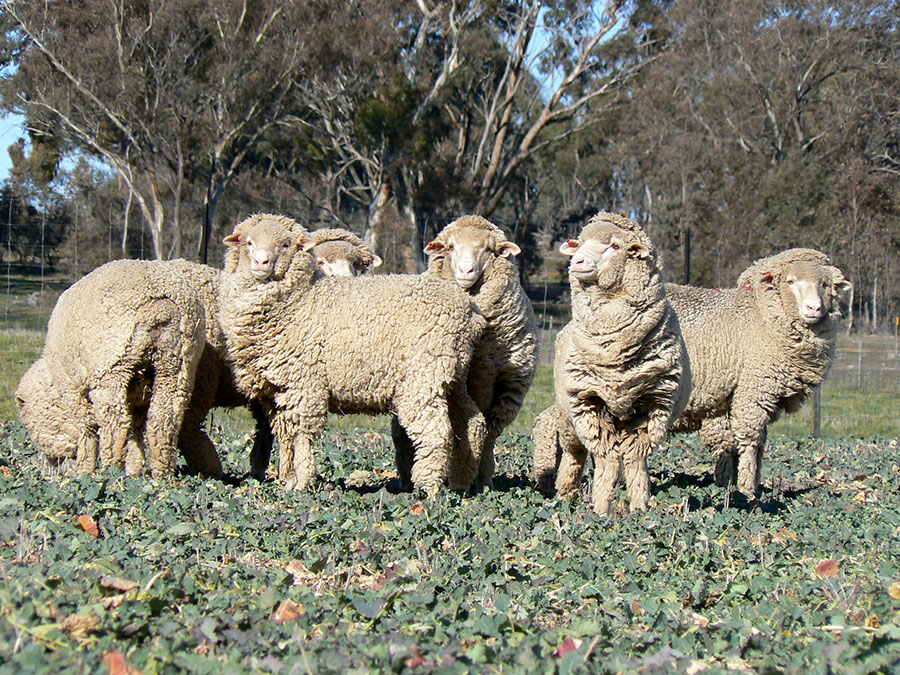
Sheep grazing dual-purpose canola at CSIRO’s Ginninderra Experimental Research Station, ACT.
Dr John Kirkegaard from CSIRO Agriculture and Food says that almost 20 years of experiments, computer simulation modelling and on-farm experiences have generated a clearer picture of the management needed to maximise early forage production.
- Weed control – strict and effective summer weed control to conserve nitrogen and water for early sowing.
- Residue management – facilitates ease of sowing, weed and disease control.
- Precision seeding – accurate seed and fertiliser placement when sowing in rapidly drying soils is critical.
- Sowing date – earlier-sown winter canola varieties sown from February to March will generate more biomass for grazing than later-sown spring types sown in April.
- Nitrogen supply – adequate nitrogen (150kg/ha for February to March-sown winter types and 100kg/ha for April-sown spring types) is required at or soon after sowing to maximise early biomass production.
- Variety type – despite some overlap, hybrid canola produces more biomass earlier than conventional open-pollinated (OP) canola, while triazine-tolerant (TT) varieties produce the least. Hybrid-TT varieties produce more biomass than OP-TT varieties.
- Plant density – target 30 to 50 plants per square metre for optimum early biomass production because grazing generally does not start before the six-leaf stage, and early sown crops grow quickly in warm conditions.
- Residual dry matter – ensure residual dry matter after grazing is adequate, with at least 2.5t/ha or higher with late grazing.
More information: John Kirkegaard, john.kirkegaard@csiro.au

























































